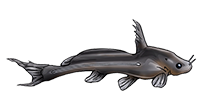Feeding ecology of Pterodoras
- Silurus
- Posts: 12420
- Joined: 31 Dec 2002, 11:35
- I've donated: $12.00!
- My articles: 55
- My images: 893
- My catfish: 1
- My cats species list: 90 (i:1, k:0)
- Spotted: 424
- Location 1: Singapore
- Location 2: Moderator Emeritus
- MatsP
- Posts: 21038
- Joined: 06 Oct 2004, 13:58
- My articles: 4
- My images: 28
- My cats species list: 117 (i:33, k:0)
- My aquaria list: 10 (i:8)
- My BLogs: 4 (i:0, p:97)
- Spotted: 187
- Location 1: North of Cambridge
- Location 2: England.
Re: Feeding ecology of Pterodoras
I have put a link to this paper in the Cat-eLog data sheet of P. granulosus.
--
Mats
--
Mats
- sidguppy
- Posts: 3827
- Joined: 18 Jan 2004, 12:26
- My articles: 1
- My images: 28
- My aquaria list: 5 (i:0)
- Spotted: 9
- Location 1: Southern Netherlands near Belgium
- Location 2: Noord Brabant, Netherlands
- Interests: African catfishes and oddballs, Madagascar cichlids; stoner doom and heavy rock; old school choppers and riding them, fantasy novels, travelling and diving in the tropics and all things nature.
- Contact:
Re: Feeding ecology of Pterodoras
a very interesing read, to be recommended!
this confirms my own observtions. i've kept this prticular species from 2" up to 16" and the larger it gets, the more herbivorous it feeds
also; the migratory habits also show and this papers confirm; during the rainy season (september till march) this fish gets very lively in captivity.
wich makes sense, because it's supposed to migrate from the rivers to the now flooded forests to feed on terrestrial vegetayion
my own observations include the fact that it can and does feed on terrestric plants, wich is shown by the fact that even the toughest aquatic plants like cryptocoryne (wich contain a lot of silicates), java ferns, Anubias and Giant Vallisneria get eaten by the largest fishes.
small ones are already capable of feeding on aponogeton, echinodorus and hygriphila wich are all aquatic and more soft-leafed.
this confirms my own observtions. i've kept this prticular species from 2" up to 16" and the larger it gets, the more herbivorous it feeds
also; the migratory habits also show and this papers confirm; during the rainy season (september till march) this fish gets very lively in captivity.
wich makes sense, because it's supposed to migrate from the rivers to the now flooded forests to feed on terrestrial vegetayion
my own observations include the fact that it can and does feed on terrestric plants, wich is shown by the fact that even the toughest aquatic plants like cryptocoryne (wich contain a lot of silicates), java ferns, Anubias and Giant Vallisneria get eaten by the largest fishes.
small ones are already capable of feeding on aponogeton, echinodorus and hygriphila wich are all aquatic and more soft-leafed.
Valar Morghulis





